What is SoS and How Do You Use it to Build Links?
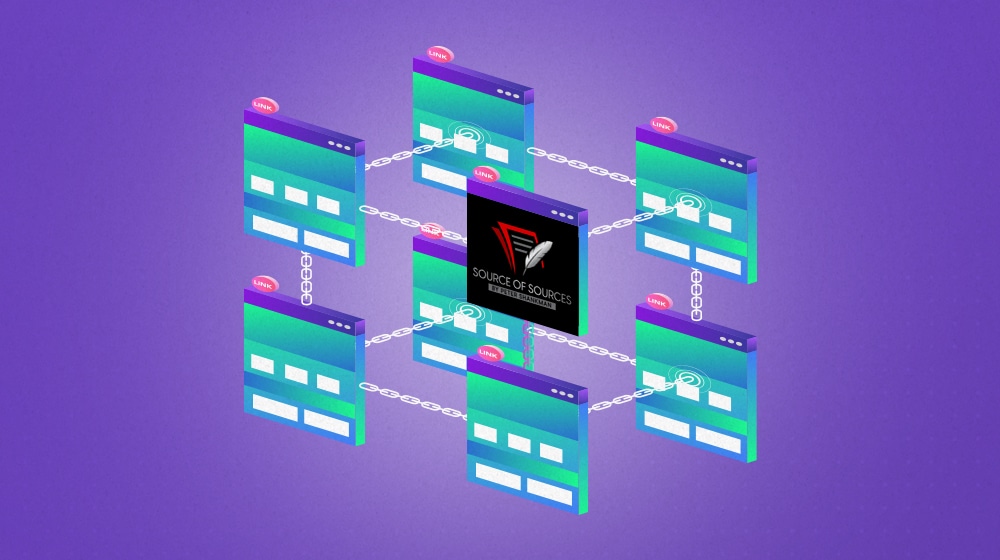
All the way back in the far-off year of 2008, a man named Peter Shankman saw a problem. Out there in the wider world, there were thousands of journalists working on reports on all manner of topics, and they needed people to help them out by acting as authoritative sources of information.
At the same time, there were tens or hundreds of thousands of people who could be those sources – business owners, scientists, subject matter experts, and people with specific lived experiences – and who would be more than happy to do so in exchange for a link to their websites or a shout-out by name.
The problem was that these people rarely were able to find each other. Journalists are often swamped with "tips" from people who don't really know anything relevant, and their own social circles and reach aren't necessarily very large since they're more focused on their jobs rather than their online presence.
Meanwhile, experts don't necessarily know when or how to pitch their expertise to journalists; they can't just cold email, for example, because the chances of any specific journalist working on something where their expertise would be handy are very small.
Peter decided to do something about it, and he chose to use one of the most popular tools of the time: Facebook. He created a Facebook group to connect journalists and source experts, and it proved to be a wild success. Soon, it was unsustainable to manage it as a Facebook group, so he transitioned it into an email mailing list, which later expanded into a whole platform.
That platform was Help A Reporter Out, or HARO.
In the sixteen years since, HARO saw a lot of changes, but also a lot of stagnation. Though the site developed, the back end was still an elaborate system of mailing lists and direct emails. In 2010, the PR firm Vocus acquired the platform and ran it until 2014, when they merged with Cision, one of the largest PR Platforms in the world. It persisted largely unchanged, though it was rebranded as Connectively at one point. That's where it remained for a decade, until the end of last year, when Cision decided to shutter the service.
What does all of this have to do with SoS? I'm getting to that.
What is SoS?
When Vocus bought HARO, Peter Shankman left the service. For many years, he worked in marketing and social media, writing books, giving speeches, launching startups, and more.
When it was announced that Connectively was shutting down, thousands of people who loved the platform tracked down Shankman and begged him to build a new one! Initially, he didn't want to – after all, there are plenty of imitators out there already – but people kept on asking, and finally, he gave in.
SoS, known more formally as SourceOfSources.com was born.
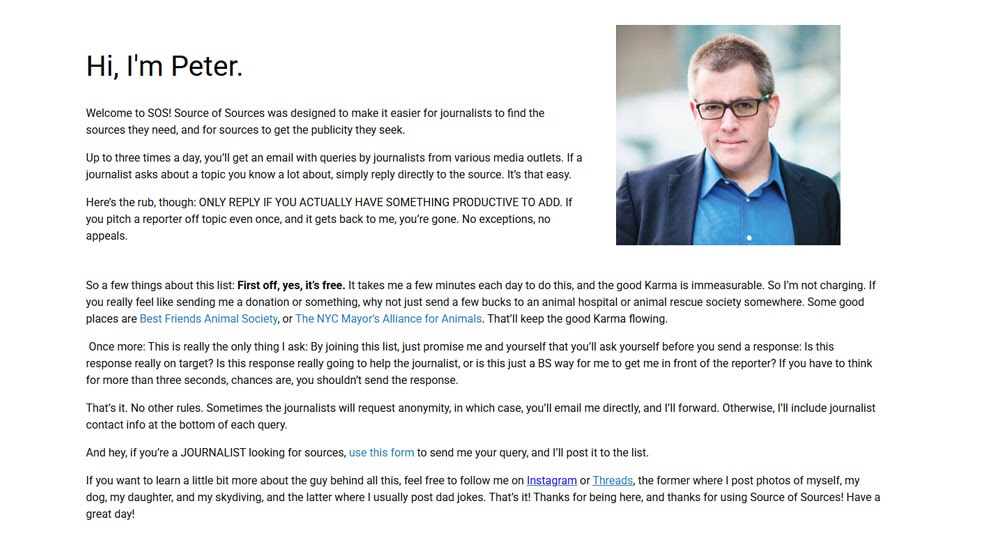
There are, however, a bunch of things that make SoS different, both from how HARO worked and from how other competitors like SourceBottle or Qwoted work today.
Source Of Sources feels like a retro platform, but it's not even a year old. That's both good and bad; it's still young and still has a lot of growing to do, but you know that it's relatively fresh; you don't have to worry about volumes of dead accounts or anything of the like.
A big part of this has to do with how Source of Sources works. Let's go through it and talk about the pros and cons of the platform and how to use it effectively.
How Source of Sources Works
If you're used to the other platforms, with their limits on pitches and their paid plans and all the rest, you're going to be pleasantly surprised by Source of Sources. SoS is, at its heart, nothing more than a mailing list. Shankman decided to go back to his roots, and he's a firm believer in the power of email, so it's a natural choice.
The way Source of Sources works is very simple. I'll go through it from both sides.
Using Source of Sources as a Publisher
If you're a business owner, subject matter expert, or publisher, all you do is visit the SoS website and fill out the box at the top. First name, last name, and email address; that's all you need. It signs you up for the mailing list. No accounts are needed, and there is no payment portal, free trial, or credit system. Sign up, and you're in.
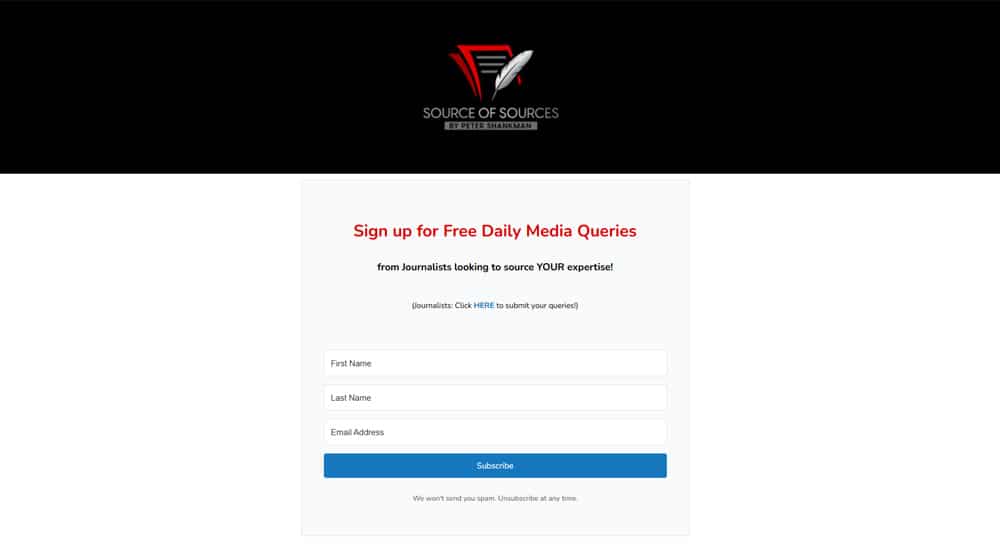
Now what happens? 1-3 times a day, depending on the volume of journalist requests the services get, you will get an email with opportunities. They'll take a pretty basic form: a simple request from a journalist with what they need and contact information. You can choose to ignore the opportunities (which you'll do a lot since you won't have anything relevant to say for most of them), or you can respond to the opportunity with your pitch.
Note that sometimes, the journalist will request anonymity. When that happens, your response goes to Shankman instead, and he'll forward it to the journalist. It's a way for journalists from the more high-profile media outlets or journalists working on sensitive topics to avoid being spammed or doxed.
That's basically it! There are no charges and no real rules, except for the main rule of "don't spam the journalists." Shankman watches what goes on in his platform, and if a journalist is getting spammed or a publisher is sending out tons of irrelevant, GPT-written pitches, he has no qualms about banning you from the platform. He says, and I quote:
"ONLY REPLY IF YOU ACTUALLY HAVE SOMETHING PRODUCTIVE TO ADD. If you pitch a reporter off topic even once, and it gets back to me, you're gone. No exceptions, no appeals."
He's gotta do something since there's no paywall, right? I think it's a good step. Don't bite the hand that feeds, and you'll be fine.
Using Source of Sources as a Journalist
Using SoS as a journalist is also pretty simple. You start by going to the reporter page and filling out the form.
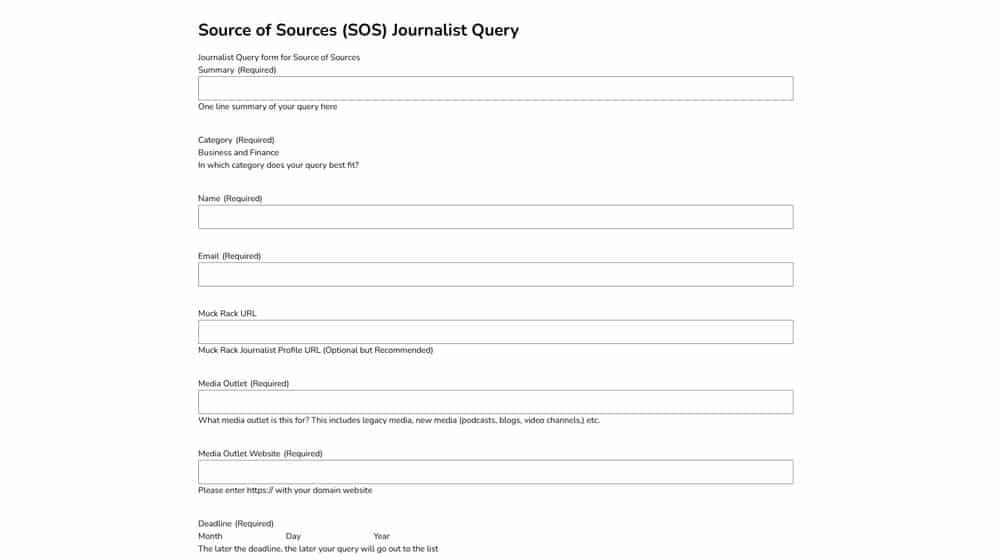
It's a bit more complicated than the business side and asks for a bunch of relevant information.
- Your summary. This is a one-line "title" summary of what you're asking for.
- The category of your request. Possible categories are Business and Finance, Technology, Travel, Lifestyle and Entertainment, Healthcare and Pharma, or General.
- Your name.
- Your email address.
- Your profile URL for Muck Rack (optional.)
- The name of your media outlet.
- The website for your media outlet.
- Your deadline. The later the deadline, the longer it takes for your request to be sent to the list, so people with tighter deadlines get priority.
- Whether or not your request is urgent (which pings Shankman to prioritize sending out your request). Note that abusing this feature can get you removed from the platform.
- The text of your query: who you want to talk to, what subject you want to talk to, what kinds of people you don't want to talk to.
You also have the option for super-urgent (four hours or less from the time of submission deadlines) to forward the confirmation auto-reply to Shankman's special urgent email, which gets you a post on his Threads account. I did a quick scroll-through of his feed and didn't see any, so this feature doesn't seem to be very frequently used, which is fine.
Your request gets sorted into the queue according to deadline priority, and then it's sent out at some point in one of the daily digests of requests. When it goes out, you'll start getting emails directly from possible sources, and you can follow up with any that sound promising. You can also report the spammiest ones to Shankman to have them removed from the platform, though the threat of being removed seems to generally keep most of them away.
How Much Does Source of Sources Cost?
Absolutely nothing but your time.
If we're being real here, I don't think Shankman really wanted to make another HARO. He's filling a need for a service with his name attached, but I'm sure he has a lot of it automated and only looks at it when he gets urgent pings or reports of abuse. For the most part, it runs on its own and probably will until such time as it grows too large to be sustainable the way it is.

If you want to pay something anyway, Peter asks that you donate to an animal rescue or animal hospital. He recommends a couple of NYC-based animal charities because he lives in NYC, but the point is, he doesn't want money for the service (he has enough from multiple books and startups) and would prefer you direct your funds somewhere they can do good in the world.
What Are the Pros and Cons of Source of Sources?
The list of pros and cons of Source of Sources is pretty much what you might expect.
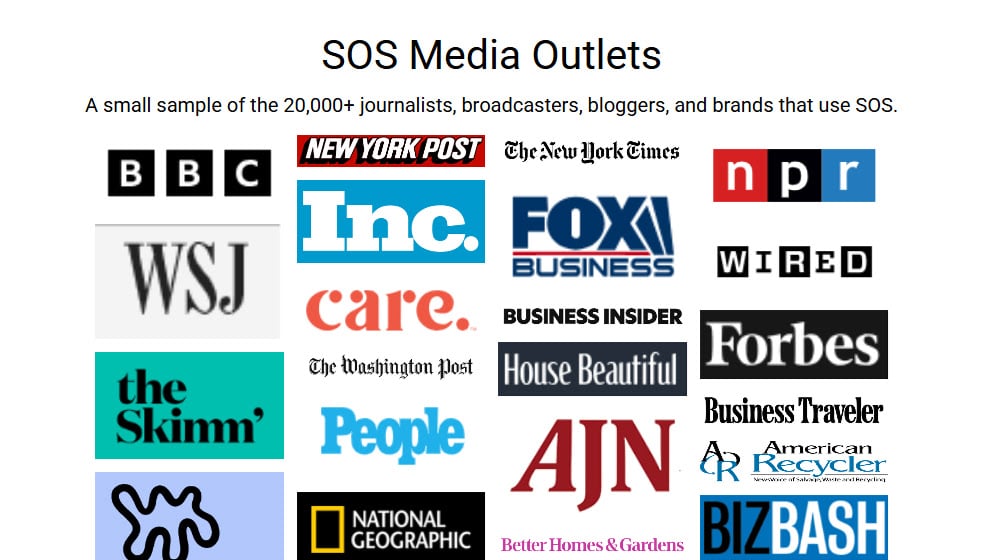
On the Pros side:
- It's very simple and easy to use. As a publisher looking for link-building opportunities, all you need to do is sign up, refine your pitching process, and wait for good opportunities.
- It's free. It's pretty rare that you find a service that is both good and free, but SoS fits that bill, at least for now.
- It's relatively new, but from a trusted name, so a lot of decent or good media outlets (BBC, NYT, Wired, NPR, etc.) have signed up and used it.
On the other hand, there are some cons.
- There's no real nuance to the services offered. You can't add filters, manage an account, set up a profile, or do anything else since it's literally just a newsletter and some email outreach.
- There's not much way to stand out to journalists or gain an advantage as an enterprise. No limiters to bypass, no top-tier sources to access, nothing; you're just one of the crowd and have to stand out on your own merits.
- It's all managed through email, so if you're not really good at putting together emails, you're going to have a bad time. My tip: set up desktop or phone notifications for the SoS emails.
Overall, I think Source of Sources has a lot of potential, but you need to use it right to get the most out of it.
How Can You Use Source of Sources for Your Link Building?
Using Source of Sources for link building is pretty easy, but at the same time, it's surprisingly complicated.
Step 1: Sign up for the newsletter. There's nothing really nuanced about this, no profile to fill out or paid tier to choose, just fill out the opt-in on the homepage.
Step 2: Watch the emails. They'll come in a few times a day, more often during busier days, and the timing isn't necessarily consistent. Unfortunately, that means you need to be ready and able to drop everything and send a response if you see a good one come in or risk losing the opportunity.
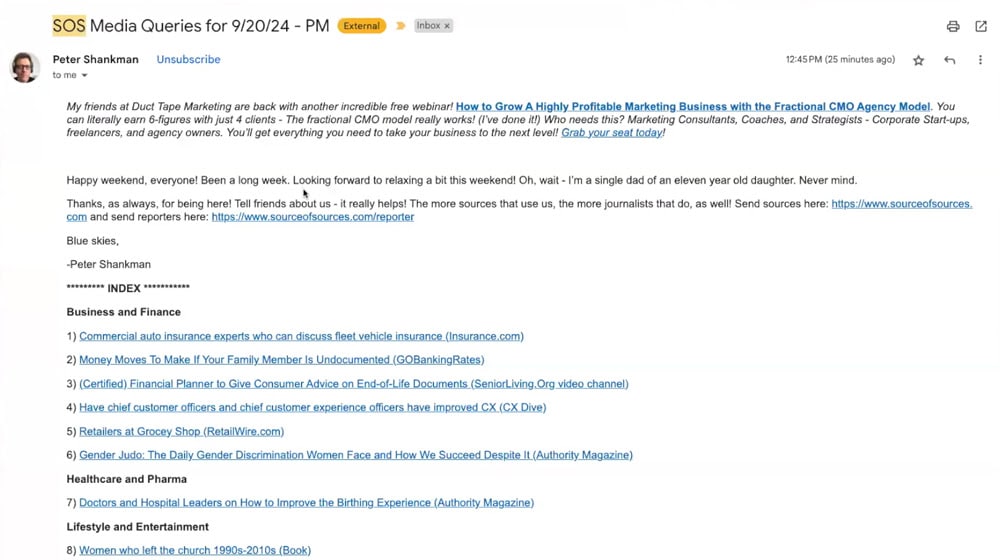
Step 3: Learn how to send a good pitch. I have a whole guide on writing good pitches (for CisionOne, the HARO successor from Cision), but the advice I give largely applies to pretty much any of the Connectively alternatives and HARO-like platforms. The only difference with using Source of Sources here is that you don't have a profile to fall back on, so your singular email needs to do all of the heavy lifting.
Step 4: Don't abuse the platform. Shankman will block you from his list if a journalist reports you sending them irrelevant nonsense, and I don't blame him. Try to limit yourself to the most laser-focused pitches for topics you're definitely an expert in, and you'll be fine. I also recommend avoiding using GPT to write pitches for you; trust me, the journalists can tell.
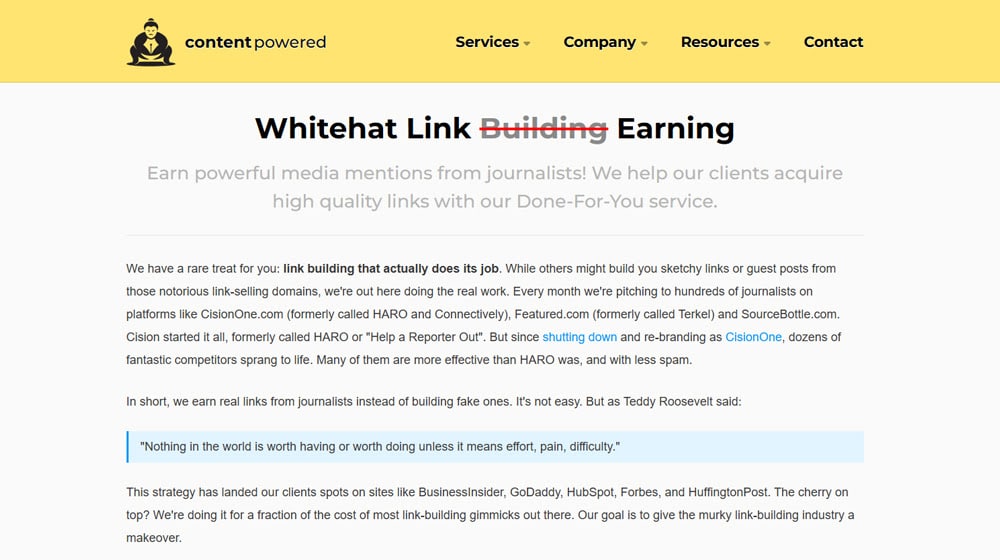
Unfortunately, there aren't any really deep or tricky tips I can give you for Source of Sources since it's all just simple email exchanges, and there's nothing to the platform to make it unique. But, if you want, I'm more than willing to just do it for you. My link-earning service makes use of all of the biggest PR platforms, including Source of Sources, so if you want an expert to handle it for you, I'd be happy to.







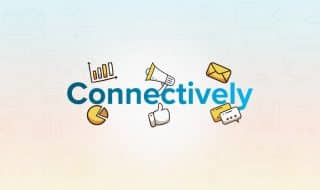


January 24, 2025
Great article! The fact that it's free and brings opportunities from sites like the BBC and Wired is a huge plus
January 24, 2025
Thanks nop!
July 20, 2025
Wow, SoS feels like Peter Shankman looked HARO in the eye, whispered 'let’s try that again but with less corporate weirdness' and then hit send. I’ve been testing it out myself and while it’s a little like speed-dating for backlinks the simplicity is refreshing. It feels oddly nostalgic clicking through daily source requests like it's 2010 again
July 29, 2025
Too funny!